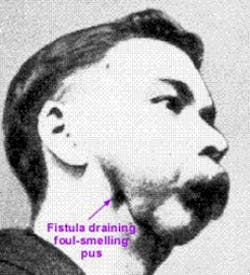Modern occupational hygiene practices help reduce cases of phosphorus necrosis of the jaw
One of the workshop sessions was “Emerging Science That Influences Practice.” One of the presenters of that workshop was Philippe Hujoel, PhD, DDS, MSD, MS. Dr. Hujoel has a DDS from the University of Brussels, Belgium, an MSD and a PhD in epidemiology from the University of Washington, and an MS in biostatistics from the University of Michigan. He is a Professor, Oral Health Sciences, and Adjunct Professor, Epidemiology, at the University of Washington. He also maintains a private practice in Shoreline, WA. His research interests include: etiology and treatment of oral and craniofacial diseases; outcomes assessment of periodontal therapy; and the role of nutrition in dentistry Dr. Hujoel has over 100 publications in peer-reviewed journals and has authored several book chapters on epidemiology and periodontics. The recipient of numerous awards, he has served on the editorial boards of several dental journals and has given dozens of scientific presentations at sites around the world. This article is a synopsis of the workshop.Dr. Hujoel reviewed the risk of bisphosphonate-induced osteonecrosis of the jaws based on new findings from several large studies, including data from the NIDCR-funded trans-dental practice-based research networks (CONDOR) studies.(1,2)
He began by explaining “Phossy jaw”, formally phosphorus necrosis of the jaw. It is described as an occupational disease of those who work with white phosphorus, also known as yellow phosphorus, without proper safeguards. It was most commonly seen in workers in the match industry in the 19th and early 20th century. Modern occupational hygiene practices have eliminated the working conditions which caused this disease.Links to bisphosphonates
A related condition, bisphosphonate-associated osteonecrosis of the jaw (BON), has been described as a side-effect of amino-bisphosphonates, a class of phosphorus-based drugs that inhibit bone resorption, and are used widely for treating osteoporosis, bone disease in cancer and some other conditions.(3) BON is primarily associated with the use of intravenous bisphosphonates in the treatment of cancer. The percentage incidence of BON from this use is approximately 1,000 times higher than the incidence of BON caused by the use of oral bisphosphonates.(4)
1. Hujoel P for the CONDOR Collaborative Group. Bisphosphonate-related osteonecrosis of the jaws. Second North American Conference on Dental Hygiene Research. October 20-22, 2011. Bethesda, Maryland.2. Research Reports - Clinical: Barasch A, Cunha-Cruz J, Curro FA, Hujoel P, Sung AH, Vena D, Voinea-Griffin AE, and the CONDOR Collaborative Group. Risk Factors for Osteonecrosis of the Jaws: a Case-Control Study from the CONDOR Dental PBRN J Dent Res April 2011 90: 439-444, first published on February 11, 2011 doi:10.1177/0022034510397196.3. Durie BG, Katz M, Crowley J (July 2005). "Osteonecrosis of the jaw and bisphosphonates". N. Engl. J. Med. 353 (1): 99–102; discussion 99–102.4. Cartsos VM, Zhu S, Zavras AI (January 2008). "Bisphosphonate use and the risk of adverse jaw outcomes: a medical claims study of 714,217 people". J Am Dent Assoc 139 (1): 23–30.5. Hellstein JW, Adler RA, Edwards B, Jacobsen PL, Kalmar JR, Koka S, Migliorati CA, Ristic H, for the American Dental Association Council on Scientific Affairs Expert Panel on Antiresorptive Agents. Managing the care of patients receiving antiresorptive therapy for prevention and treatment of osteoporosis. Executive summary of recommendations from the American Dental Association Council on Scientific Affairs. The Journal of the American Dental Association November 1, 2011 vol. 142 no. 11 1243-1251. www.ada.org/sections/professionalResources/pdfs/topics_aronj_report.pdf. Accessed Nov. 7, 2011. 6. Landesberg R, Eisig S, Fennoy I, Siris E. Alternative indications for bisphosphonate therapy. J Oral Maxillofac Surg 2009;67(5 suppl): 27-34.7. Edwards BJ, Hellstein JW, Jacobsen PL, Kaltman S, Mariotti A, Migliorati CA; American Dental Association Council on Scientific Affairs Expert Panel on Bisphosphonate-Associated Osteonecrosis of the Jaw. Updated recommendations for managing the care of patients receiving oral bisphosphonate therapy: an advisory statement from the American Dental Association Council on Scientific Affairs (published correction appears in JADA 2009;140[5]:522). JADA 2008;139(12):1674-1677.8. Lo JC, O’Ryan FS, Gordon NP, et al; Predicting Risk of Osteonecrosis of the Jaw with Oral Bisphosphonate Exposure (PROBE) Investigators. Prevalence of osteonecrosis of the jaw in patients with oral bisphosphonate exposure. J Oral Maxillofac Surg, 2010;68(2):243-253.9. Lazarovici TS, Mesilaty-Gross S, Vered I, et al. Serologic bone markers for predicting development of osteonecrosis of the jaw in patients receiving bisphosphonates. J Oral Maxillofac Surg, 2010;68(9):2241-2247.10. Lee CY, Suzuki JB. CTX biochemical marker of bone metabolism: is it a reliable predictor of bisphosphonate-associated osteonecrosis of the jaws after surgery? Part II: a prospective clinical study. Implant Dent 2010;19(1):29-38.11. American Dental Association (ADA) Division of Science. For the Dental Patient. Osteoporosis medications and your dental health. The Journal of the American Dental Association November 1, 2011 vol. 142 no. 11 1320.12. referasmoker.org/. Additional reading
1. National Osteoporosis Foundation. Bone health basics: why bone health is important. www.nof.org/aboutosteoporosis/bonebasics/whybonehealth. Accessed Nov. 7, 2011.2. Bauer DC, Black DM, Garnero P, et al. Change in bone turnover and hip, non-spine, and vertebral fracture in alendronate-treated women: the fracture intervention trial. J Bone Miner Res 2004;19(8): 1250-1258.3. Silverman SL, Watts NB, Delmas PD, Lange JL, Lindsay R. Effectiveness of bisphosphonates on nonvertebral and hip fractures in the first year of therapy: the risedronate and alendronate (REAL) cohort study. Osteoporos Int 2007;18(1):25-34.4. McClung MR, Geusens P, Miller PD, et al. Effect of risedronate on the risk of hip fracture in elderly women. Hip Intervention Program Study Group. N Engl J Med 2001;344(5):333-340.5. Kurtzman GM, Silverstein LH, Peden J, and Shatz PC. Implications of bisphosphonate use for the dentist. Implant Dentistry Today. February 2007 Volume 1 Number1, pp.24-33.6. Goldie MP. Bisphosphonate use and osteonecrosis of the jaw: association or risk based on evidence? ACCESS, 2009.7. Task Force on Bisphosphonate-Related Osteonecrosis of the Jaws: American Association of Oral and Maxillofacial Surgeons Position Paper on Bisphosphonate-Related Osteonecrosis of the Jaw—2009 Update. www.aaoms.org/docs/position_papers/bronj_update.pdf. Accessed Nov. 7, 2011.
Maria Perno Goldie, RDH, MS
To read previous articles in RDH eVillage FOCUS from 2011 written by Maria Perno Goldie, go to articles.










